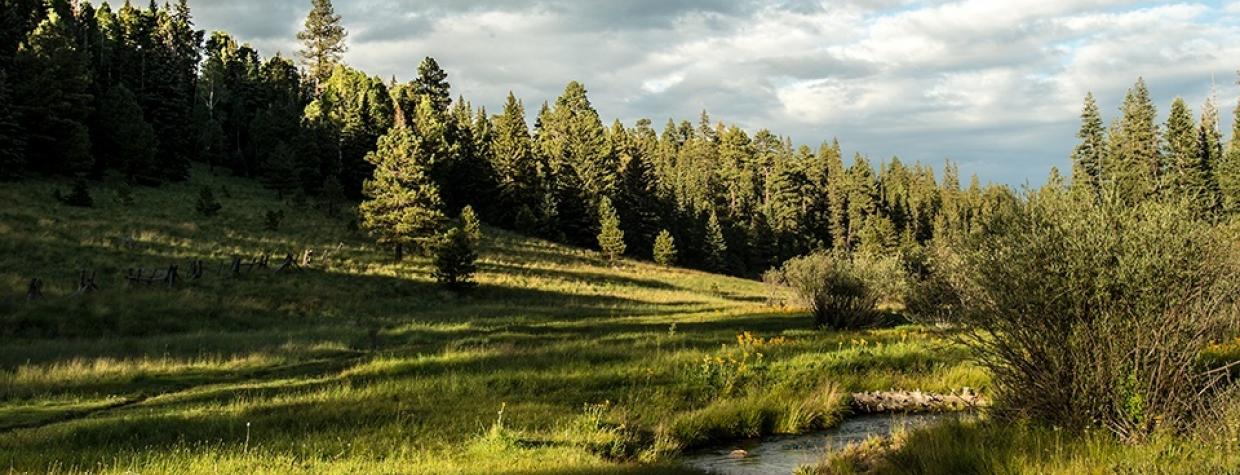White Mountains, Apache-Sitgreaves National Forests
‘‘A saturated meadow, sun-shaped and jewel-small; a circle scarcely wider, than the trees around were tall.” Robert Frost had a way with words. He also had a knack for finding Mother Nature’s simple beauty. As a New Englander, most of his inspiration came from places like Vermont and New Hampshire. Had he spent a little time in Arizona, he might have found a similar muse in the magnificent White Mountains.
Like rural New England, the White Mountains are an inspiration for poets — plenty of meadows and trees and birds in the sky. It’s a great place for hikers, too, especially the West Baldy Trail. For peak-baggers in Arizona, this hike is one leg of the Triple Crown — along with Humphreys Peak near Flagstaff and Escudilla Mountain near Alpine. For everybody else, it’s an easy way to sample the best of the backcountry. Corkbark firs, ponderosa pines, white firs, Engelmann spruce, 5 miles of trout streams, lush meadows, black bears, deer, mountain lions and a cool, wet climate (the temperature rarely tops the 70s in the summer) make this one of the most beautiful places in the Apache-Sitgreaves National Forests.
The first 2 miles of West Baldy cut through a series of wide alpine meadows and follow the West Fork of the Little Colorado River, which is dotted with beaver dams. You’ll get your first glimpse of the water after about 15 minutes. Five minutes later, you’ll enter the Mount Baldy Wilderness. Looking around, you’ll understand why this area was granted the ultimate protection. Of course, that also makes this one of the busiest stretches of the trail, but as the hike gets a little tougher, the crowds thin out.
After about an hour, the trail enters a thick forest dominated by spruce, firs and aspens — other than a few small meadows, the trail won’t break out of the timber until the top. At the 90-minute mark, you’ll cross a stream and begin a series of steep switchbacks — overall, the hike won’t kill you, but the altitude and the distance do have an effect. Moving on, the trail continues its ascent to a hillside covered with fallen logs. Big logs. Lots of logs. Imagine what it would look like if Paul Bunyan had spilled a giant can of giant Lincoln Logs. That’s what comes to mind, but in reality, the dead trees are the victims of bark beetles, which clobbered the area during the height of the drought in 2002 and 2003. Bears seem to like this area, too. Be on the lookout.
From there, the switches continue through an endless stretch of gorgeous evergreens, which are interspersed with boulders the size of station wagons — one looks like Abe Vigoda. Eventually, West Baldy merges with the East Baldy Trail near the White Mountain Apache Tribe boundary. The summit of Baldy Peak is on tribal land, and it’s open only to tribal members. You’ll be tempted to “sneak” to the top; however, this is sacred land, and it must be respected. Trespassers who ignore the boundary are subject to fines and could have their packs confiscated.
If you’re a peak-bagger, here’s the good news: The highest point of the ridge isn’t Baldy Peak (11,403 feet) but an unnamed area (11,420 feet) on Forest Service land to the north. If you’re not a peak-bagger, the news is even better: The views from the top are spectacular. It’s more of Mother Nature’s simple beauty. Sit back and enjoy. That’s what Robert Frost would have done.
Length: 14 miles round-trip
Difficulty: Moderate
Elevation: 9,287 to 11,420 feet
Trailhead GPS: N 33˚57.888', W 109˚30.071'
Directions: From Eagar, go west on State Route 260 for 18.7 miles to State Route 273. Turn left onto SR 273 and continue south for 8.6 miles to the trailhead at Sheeps Crossing.
Vehicle Requirements: None
Dogs Allowed: Yes (on a leash)
Horses Allowed: Yes
USGS Map: Mount Baldy
Information: Springerville Ranger District, 928-333-6200 or www.fs.usda.gov/asnf

